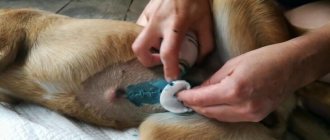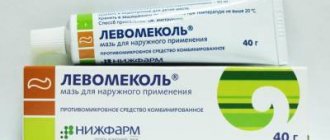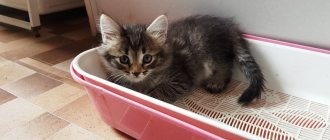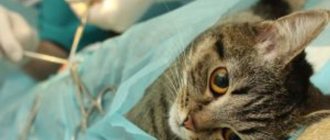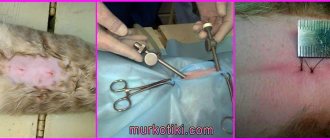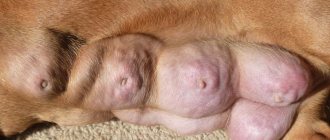Removing a cat's uterus is a standard procedure that is performed during the animal's puberty. Surgical intervention is not dangerous; the main condition is to provide adequate care for your pet after the operation.
The operation is recommended from the age of six months. To prepare the animal for surgery and anesthesia, it is recommended to undergo an examination, complete general and biochemical blood tests and visit a cardiologist.
The operation is performed under general anesthesia and involves the complete removal of the reproductive organs: the uterus and ovaries. There are various techniques for performing this operation. The difference lies in the type of surgical approach: the classic method with laparotomy access along the white line, the laparoscopic method and the method with removal of the uterus through a lateral approach.
It is also possible to apply different skin sutures: a regular suture, which must be removed after complete healing of the surgical wound, and an intradermal cosmetic suture, which simplifies postoperative care and does not require removal.
In the postoperative period, in order to minimize postoperative complications, it is important to treat the sutures with an antibacterial solution and cover them from licking by animals. For this purpose, special veterinary blankets and collars are used.
Also, due to a decrease in activity, most sterilized animals tend to gain weight. It is recommended to closely monitor this and, if necessary, switch the animal to a special diet.
When is pyometra performed on a cat?
- The animal has no appetite or it is reduced;
- Increased thirst;
- The pet's belly is increased in volume;
- From the selection loop. Cloudy white or bloody, they have a strong unpleasant odor;
- The cat is vigorously licking its belly. This can last so long that the fur falls out completely;
- The animal is more anxious or angry than usual.
Any of these signs is a reason to immediately take your pet to a veterinary hospital. The thin wall of the uterus may rupture. Then the pus enters the abdominal cavity. In this case, saving the animal is more difficult.
Before performing the operation, the doctor prescribes an ultrasound to confirm the diagnosis. This disease is not treated with medication, because This method is considered dangerous. An older cat with an early illness recovers quickly.
Possible postoperative complications
Complications after planned surgical interventions develop extremely rarely and, in most cases, it depends on the individual characteristics of a particular animal.
Main postoperative complications:
- Prolonged post-anesthesia hypothermia . If a cat lies for a long time without moving, and its ears and paws feel cold to the touch, it is necessary to check its body temperature. If the readings are below 37°C, you need to put the cat on a warm heating pad, cover it with any natural piece of fabric and contact your veterinarian for advice.
- Intra-abdominal bleeding. If traces of fresh blood are detected in the suture area or from the vulva, with obvious pain in the abdomen and pallor of the skin, you should immediately take the cat to a veterinary hospital to stop possible bleeding in the abdominal cavity. If internal bleeding is confirmed, then repeated surgery is performed.
- Postoperative hyperthermia. If body temperature is elevated for more than 3 days (above 39°C), it is necessary to consult with a veterinarian or take the cat to an appointment for direct examination by a specialist.
- Redness around the stitch and swelling. This condition of the suture is allowed for 3-5 days, provided that there is no discharge from the wound. After 5 days, both redness and swelling will begin to subside and will completely disappear by the time the stitches are removed.
- Rotting postoperative suture. If the cat's postoperative hygiene measures are not followed, dirt may get into the seam, causing it to fester. It is imperative to show the animal to a doctor. If the prescribed drugs for local treatment do not help eliminate such signs, the doctor will have to remove the stitches, remove the damaged areas of skin around the wound under anesthesia and re-suture it.
- Lump on the abdomen in the suture area. If an enlarged area is detected anywhere around the seam, this is a reason to consult a veterinarian. There are two options for lumps after sterilization - this is post-operative swelling, which may have to be opened, or the growth of granulation tissue (“young” skin), which will go away on its own within a month and a half.
How is abdominal surgery performed?
There are two polar opinions among cat owners. Some advocate for naturalness and allow their pets to give birth. Others, and more and more of them every year, are inclined to the opinion of animal rights activists who are against unwanted and uncontrolled pregnancies.
Pros:
- prevention of unwanted pregnancy, a humane way to deal with stray animals;
- increased life expectancy, a sterilized cat lives 2-4 years longer;
- reducing the risk of cancer of the uterus, ovaries and mammary glands;
- reducing the risk of contracting sexually transmitted infections;
- the animal becomes calmer and more affectionate;
- Sterilized cats have a slower metabolism and need less food;
- absence of unwanted behavioral reactions during sexual activity.
Minuses:
- sterilization is a surgical intervention, so complications are possible, both from anesthesia and in the postoperative period;
- the first two weeks after the operation you will have to observe the cat so that it does not damage the integrity of the sutures;
- there may be an increase in appetite.
With careful attention to the cat and proper care, all the disadvantages are covered by the advantages. Remember, you are responsible for your pet!
Is it possible to do without surgery?
Today there is no alternative to sterilization. If you think that it is better to let the cat suffer several times a year or, worse, it is better to give pills that suppress sexual activity, then you are mistaken.
- Firstly, watching and hearing the suffering of a willing animal is a test for the owners, and imagine how hard it is for the animal.
- Secondly, frequent and long-term use of anti-estrus pills is very harmful to your pet’s health.
Therefore, before getting a cat, decide why you are doing this and how to make your pet’s life as long and comfortable as possible.
The most important thing you must remember is that the operation (removal of the animal’s ovaries and uterus), although not so complicated, must be carried out by a highly qualified doctor in a veterinary clinic!
Removal of the ovaries and uterus is carried out through an abdominal incision (on the stomach), so immediately before the operation the cat's hair is shaved off on the stomach or slightly on the side. The animal is then put under general anesthesia, an incision is made in the abdomen, sterilized and finally stitches are placed.
Large veterinary clinics offer the service of sterilizing cats at home. This is a reasonable alternative to in-clinic surgery.
Advantages of sterilization at home:
- the cat does not experience the stress that could be experienced during transportation to a medical facility;
- the animal recovers faster in familiar conditions;
- the owner saves time and money on transportation.
Minuses:
- the price of the operation depends on the distance of your home from the clinic (mileage is taken into account);
- It is difficult to maintain sterility at home.
Before you decide to call a specialist at home, you need to inquire about the qualifications of the surgeon, find out how to prepare the cat and the room in which the operation will be performed.
We suggest you read: How to treat ringworm in cats: how to identify ringworm - symptoms and initial stage of ringworm - what to do if your cat has ringworm and what it looks like
What you will need for the operation:
- Clean, well-lit room.
- An ordinary desk or kitchen table is suitable for a surgeon’s work. The size of the tabletop is at least 100 by 70 cm.
- Thick towel (60 by 30 cm)
- Place for placing a medical case.
The animal is prepared in the same way as before surgery in a veterinary clinic.
Russia:
- Moscow and St. Petersburg - 3200 - 4300 rubles;
- Regions of Russia - 3000 - 5500 rubles.
Ukraine:
- Kyiv - 900 - 1000 hryvnia;
- Regions of Ukraine – 400 – 650 UAH;
The cost of the operation may depend on the distance of your home from the veterinary clinic.
Is it necessary to remove the uterus?
Previously, the issue of removing the uterus during sterilization was raised. Still, is it necessary to cut out the uterus? The answer is rather positive.
It is better to remove the uterus, because after sterilization the body no longer needs the uterus, and it often happens that it becomes inflamed (endometritis), or purulent contents accumulate in it (pyometra), or, even worse, malignant tumors may appear. And if the uterus was removed during sterilization, then these problems do not arise due to its absence.
Important!
Many cat owners, due to their illiteracy, are convinced that a cat should “experience the joy of motherhood” at least once in its life.
How to care for a cat after hysterectomy?
Typically, cats recover surprisingly quickly after surgery. But some veterinarians may leave the cat under their care for 12 to 24 hours to make sure everything is okay. If your doctor offers you exactly this option, do not refuse.
Because, unlike castration of cats, surgery in cats requires more serious surgical intervention and the observation of a specialist after the operation will not be superfluous.
To make the postoperative period as comfortable and safe as possible, take care of the following:
- Prepare a bed for your cat. After the operation, the animal will experience discomfort and may shiver. Before leaving for the clinic, prepare a warm, cozy, secluded, but at the same time easily accessible place that will be protected from an abundance of light, noise and drafts. The bedding on which the pet will lie must be cotton, lint-free, soft, clean, ironed.
- Place the bed on the floor. When a cat recovers from anesthesia, it sways, it walks unsteadily, and coordination of movements is impaired for some time. In this state, a cat or cat can easily fall off a sofa or chair.
- Monitor the animal's activity. To avoid damaging the integrity of the seams, you need to protect the cat from excessive activity.
- Remove the litter from the tray. Until the surgical wounds heal, place disposable diapers or toilet paper in the tray and keep the toilet clean. Both large and small fillers can injure or clog the wound after surgery.
- Use an Elizabethan collar if the animal has an increased interest in postoperative sutures and tries to lick and comb them. Put it on your cat until the stitches are removed. Usually the sutures are removed 10-12 days after surgery. Don’t think that if an animal licks its wound, it will heal faster. On the contrary, the wound can become infected or injured.
- Use a special blanket to protect the seams from the cat's encroachment and the ingress of dirt and germs.
- Adjust your cat's diet. Remember that sterilized cats are prone to obesity because they need less food than their regular counterparts. It is important to adjust your diet to avoid obesity. Cats are transferred to specialized food for sterilized animals. If you feed your animal natural food, then you need to reduce the number of feedings and the serving size.
The behavior of a cat after sterilization, as a rule, depends on the method used to operate it.
After laparoscopy
Usually, after sterilization by laparoscopy, the animal's behavior remains unchanged.
Your cat may be sleepy and lethargic for several hours after surgery. But, as a rule, everything is restored in a very short time and by the evening the animal can behave practically as if nothing had happened.
If sterilization was carried out using the classical method of abdominal surgery, the recovery period is much longer and it proceeds with various restrictions in the life of the animal.
After abdominal surgery, the animal can sleep for several more hours due to the effects of anesthesia. It is best to leave the cat for a while in the clinic under the supervision of doctors.
Lethargy, disorientation, unsteady gait, chills - all these signs can appear in a cat during recovery from anesthesia. The owner will have to follow the cat on its heels to avoid unpleasant situations. For example, accidental falls, impacts and, as a result, possible injuries to the animal due to poor coordination of movements.
It is quite possible that postoperative pain may occur, which makes the animal restless. You should consult your veterinarian about the possibility of using painkillers. You also need to ensure that the cat does not drink or eat for 10-12 hours after surgery.
We invite you to read: Bambino - description of the breed and character of the cat
Like any surgical intervention on the body, sterilization has its complications and consequences. This is due to the fact that each organism is individual and the reaction to surgery and after it can be unpredictable. To minimize risks, you must strictly adhere to all rules and regulations.
Sometimes it is a consequence of the administration of anesthesia, even if all the rules of preparation for the sterilization operation are followed. If the vomiting is weak, then you just need to make sure that the animal does not choke in its own vomit.
You should turn your head to the side to prevent vomit from entering your respiratory tract. If vomiting is severe or uncontrollable, you should immediately seek veterinary help.
Temperature
Lack of appetite, elevated body temperature, weakness, drowsiness. This condition is, in principle, normal, especially in the first hours after surgery and for 2 days after, but no more. If you have an elevated temperature (above 39°C) for more than 1-2 days after surgery, you should immediately consult a doctor.
A drop in temperature below 37°, and if warming the pet with heating pads does not help, this is an alarming symptom, in which you also need to seek medical help.
This will be evidenced by the lethargy of the animal, the pet is constantly lying down, attempts to touch or stroke it cause pain, if you open your mouth and look at the mucous membrane it will be very pale, almost white - consult a doctor URGENTLY!
Wound infection
The presence of redness, swelling (swelling), increased discharge from the wound, if the discharge becomes purulent in nature - all this also requires immediate intervention by a veterinarian. The presence of slight redness and slight swelling or swelling is acceptable for the first 3-4 days after surgery, but no more.
Cats may exhibit behavior similar to being in heat. This is because the ovary may not be completely removed and the remaining parts of the ovary produce hormones that cause this behavior. You should seek advice from your veterinarian, preferably the doctor who performed the surgery.
Obesity
Do not forget that the use of anesthesia and hormonal imbalance slow down the metabolism. To prevent the appearance of excess weight, after the sutures have been successfully removed and the postoperative wound has healed, provide the cat with the necessary daily physical activity. Take care to create a balanced diet. Don't overfeed your pet!
Be a caring and attentive owner and if you have any suspicious symptoms, do not neglect to contact your veterinarian.
- The operation usually lasts about an hour.
- After the hospital, bring the cat home. Prepare a warm place for it in advance and cover the animal with a blanket. The transferred anesthesia causes the cat to freeze. The animal's body temperature drops by a couple of degrees.
- After a few hours, place a bowl of water next to the bed.
- If the operation was successful, the cat will begin to eat the next day.
- One day after surgery, you can feed her. Give us some dietary food. Just a third of your normal diet is enough. Add a vitamin-mineral complex.
- If 3 days have passed after surgery and the animal is not eating, be sure to consult a doctor.
- The veterinarian prescribes an antibiotic. Owners can do the injections themselves. You can also take your pet to the clinic. The injections are given subcutaneously.
It is also necessary to take care of the seam. For the first 12 hours, constantly monitor the cat so that it does not injure itself due to poor coordination. To prevent the pet from licking the scar, wear a special blanket. You may need a couple of bandages or blankets - they need to be changed when they get dirty. The cat wears the blanket until the stitches are removed, which is about 7 or 10 days after surgery.
- The seam is treated several times a day with an antiseptic solution. Carefully wipe all folds. The seam must be dry. There should be no pus or heavy odor. The doctor may prescribe a wound healing ointment. The animal is placed on its hind legs and quickly processed. Then the blanket is put on again.
- Under anesthesia, a cat does not close its eyes. Therefore, the owner must take care of them. Animals in this state do not even blink. The owner closes and opens the pet's eyelids several times an hour. It is recommended to instill contact lens solution.
We suggest you read: Where does the white wagtail live?
Be attentive to your cat and she will recover quickly. Strictly follow the veterinarian's recommendations. For any questions or unexpected situations, please contact him.
Best regards, Galina.
After operation
Please tell me, the cat had surgery today (to remove the uterus and ovaries) at 12:00 it was finished, she is now walking a little, but every half hour or hour she vomits (foam). and stretches out. like convulsions (for a few seconds, I wet her mouth with water, but she still doesn’t drink anything. Is it bad that she burps or is it supposed to be like that, if so, how long will it last, otherwise I’m very worried.
Many cats have difficulty recovering from anesthesia. She should be given an injection of Gamavit 1 ml and warm Ringer-Locke solution 10 ml... She cannot be fed for 24 hours after the operation. Make sure she doesn't climb somewhere and fall off - she's still sick from the anesthesia
But I don’t have any medicine at the moment. So it’s bad that she vomits almost all day long, or that’s what happens with cats. I keep an eye on her, I follow her all day long, wherever she goes, I go there too, I turn her around so that she doesn’t get into anything, she doesn’t like it, she rushes at me, bites and growls.
she doesn't know what she's doing. You can try giving her some water from a syringe without a needle into the corner of her mouth, 1-2 ml every hour or a little more often. At night, lock her up somewhere so she can't hurt herself. Tomorrow she will feel better. Feed her for the first few days with special canned food for cats Royal Canin Convalence or baby meat food made from beef or chicken (“Tyoma”, “Agusha”) in small portions. You can give her Enterosgel 1/2 tsp or activated carbon (1 tablet) 2-3 times a day an hour and a half after meals for a couple of days. This will help the body cleanse itself of anesthesia faster.
I had one cat sterilized according to indications, so on the second day she fed the kittens and recovered from the anesthesia (it was two-component) quite quickly, in about half an hour.
My cat gave birth to two kittens, but was unable to give birth to the next three, and I missed the time for stimulation, because I had never encountered this before. They performed a caesarean section and pulled out alive. Cher
Source
How to prepare a cat for sterilization
Sterilization of a cat is a abdominal operation, a surgical procedure performed under general anesthesia. To minimize possible complications and reduce stress levels, it is necessary to prepare your cat for surgery.
Preparation for surgery:
- Preoperative examination by a veterinarian and preliminary consultation. You need to make sure that the animal is absolutely healthy and there are no contraindications to surgery. Your doctor may order a urine and stool test. During the period of estrus, the cat is not sterilized.
- Studying the vaccination card. If your cat has never been vaccinated, or was vaccinated more than a year ago, then vaccination should be done 3-4 weeks before surgery. In the postoperative period, the cat’s body is very susceptible to infections and viruses.
- Antiparasitic treatment. 20 days before the proposed operation, the cat needs to be removed from fleas and worms (this is especially important for cats that are outdoors).
- Manicure. The cat's claws need to be trimmed to prevent the animal from scratching itself during the healing period of the postoperative wound.
- Additional examinations. If your middle-aged or older pet is predisposed to health problems due to the characteristics of the breed (British and Scottish cats), then it is quite possible to prescribe additional examination methods (taking blood for analysis, performing an ultrasound or ECG).
- Anti-stress preparation. If your cat is nervous and excitable, your doctor may prescribe sedatives a few days before surgery. These drugs are given only as prescribed by a veterinarian.
- Starvation diet. On the eve of the operation, you need to stop feeding the animal 12-18 hours before surgery, and stop giving water 5-7 hours before. Anesthesia on a full stomach causes a gag reflex, and this is dangerous before, during and after surgery.
Conclusion
The main “side effect” of castration is a change in metabolism, which creates the likelihood of obesity. After the operation, the owner will need to be more attentive to the cat’s diet and monitor its excess weight. However, it is not at all necessary that your cat will gain excess weight after surgery. If an animal leads an active lifestyle and eats properly, then nothing threatens its slender figure.
Thus, sterilization is not a dangerous operation, but it is an important and necessary procedure for a happy life for the animal and its owner.
Laparoscopy of cats
Laparoscopic sterilization of cats is a surgical operation that is performed under general anesthesia, but is minimally invasive, that is, one in which the area of intervention in the cat’s body is minimized.
The surgeon makes minimal incisions, usually not exceeding 1 cm, even if sterilization is carried out to remove not only the ovaries, but also the uterus.
Then a special instrument is inserted into the incisions - special tubes equipped with surgical devices for sterilization, a light source and a camera at the ends.
Thus, the surgeon sees what is happening inside the incisions on a special monitor, which displays an enlarged image from the laparoscope camera.
Advantages of laparoscopy
Advantages of laparoscopy over conventional abdominal sterilization surgery:
- The operation is gentle and can be performed on cats from 6-7 months to 13-15 years;
- due to minimal surgical intervention, the risk of infectious postoperative complications is practically reduced to zero;
- minimal postoperative care for sutures (treatment 1-2 times) or complete absence thereof;
- the absence of a large incision minimizes the cat’s postoperative pain;
- a milder prophylactic course of antibiotics compared to the course after abdominal surgery;
- no need to wear a postoperative blanket;
- sutures are applied with special threads that dissolve on their own, or there is a special glue that is used to seal surgical punctures;
- the animal returns to its normal lifestyle as quickly as possible after surgery.
- Do not try to save money on such an operation, as it is quite expensive compared to sterilizing a cat using the classical method. A high-quality laparoscopy cannot be cheap!
- Please check the doctor's qualifications first. The limited range of motion of the surgeon during such an operation, the decrease in the tactile sensitivity of the doctor’s hands - all this requires a highly qualified doctor who will perform the operation on your cat.
- Agree only to undergo surgery in a clinic setting. Some veterinarians may suggest doing the surgery at home. We should not forget that laparoscopic sterilization is, although gentle, with minimal intervention, still surgical, performed under general anesthesia.
- Do not agree to surgery without preparatory measures. If the veterinarian assures you that preparation for such an operation is not necessary, you can bring your cat in right now - run away from such a would-be doctor.
Care by day
During rehabilitation, it is recommended that one of the household members take a vacation. Usually a week is enough for complete recovery.
The instructions for caring for a cat after sterilization on a daily basis are simple. If at least one of the points does not correspond to the current situation, contact your veterinarian. Any deviation is a serious cause for concern.
First day
On the first day, refuse feeding and force-drink your pet using a syringe or pipette. Do not allow active movements and regularly moisturize the cornea. Monitor your bladder and bowel movements. If your pet intends to do this in the tray, place a towel under it to increase the stability of the limbs. You can simply hold the animal.
Lack of appetite, lethargy, vomiting and spatial disorientation are natural signs that accompany recovery from anesthesia. If pain occurs, contact your doctor and discuss acceptable analgesics. Increased aggression, frequent meowing and prolonged lack of movement will help you learn about unpleasant sensations.
Second day
Lack of bowel movements on the second day is a cause for concern. You will also have to contact your doctor if you are unable to move.
The pet should begin to move around and show interest in the water. Offer her some kefir or chicken broth. If you use dry food, temporarily replace it with wet food.
Limit movement within one room. It should contain a sleeping place, a tray, and feeders. Avoid freezing and rub the paws if they do not warm up on their own. You can also apply a heating pad to them.
The third day
By the third day the pain completely disappears. The animal becomes more active and begins to be interested in food. Increase your portions, but don’t rush back to your usual sizes. Let's eat more often, but little by little.
Measure your body temperature in the morning and evening. If both times are higher than normal, contact your veterinarian. This situation often requires antibiotics. Too low values are no less dangerous.
In case of prolonged absence of bowel movements, it is recommended to take laxatives. They accelerate intestinal peristalsis and stimulate fecal waste. You can find out which laxatives your cat can use by calling your veterinarian.
Fourth day
By the fourth day, the condition will completely stabilize, but to be on the safe side, it is recommended to continue to limit the space. Lack of bowel movement for more than 3 days requires urgent veterinary intervention. Don't try to solve the problem yourself and seek help.
Fifth day
On the fifth day, the animal can be released for walks in the yard or in other rooms. All this time, do not forget to monitor his safety. From this day on, the first jumps on low surfaces are allowed.
When examining the wound, scarring may be detected. Swelling and redness should disappear.
Sixth and seventh days
Behavior is completely normalized. In the absence of inflammation and suppuration on the wound, removal of the suture material is allowed.
If the cat was operated on laparoscopically, jumping and movement are allowed already on the 2-3rd day. The small seam does not come apart and does not cause severe discomfort to the cat. However, its sterility must be monitored no less carefully.
Some information about the operation
Of course, the process of sterilization itself, that is, removal of reproductive organs, is not necessary for ordinary people to know. It is important to understand that such an operation is necessary if you do not want to breed kittens.
Photo: cat in a blanket (bandage)
There are two types of cat sterilization:
- ovariohysterectomy : during the operation, all reproductive organs (ovaries and uterus) are removed;
- oophorectomy: the most common method, which involves removing only the ovaries. This type of sterilization is somewhat more dangerous than the previous one, since the non-functioning uterus remaining in the abdominal cavity can become inflamed and cause a new operation.
Veterinarians also use different methods for sterilizing cats, depending on the skill of the doctor, equipment and cost of the procedure:
- A classic option that has been successfully used for many years. The veterinarian makes an incision along the linea alba and removes the reproductive organs. The advantages of this method include its relative ease of execution, low cost of the operation, and the disadvantages are quite large, compared to others, damage to the body.
- Safer is sterilization using a side incision, which is much smaller than the classic one and causes less damage to the body. The abdominal muscles are dissected (that is, pulled apart and clamped with a blunt instrument) rather than cut with a scalpel.
- The most advanced and most expensive method of sterilization is laparoscopy. A small puncture is made in the abdominal wall through which the device is inserted. The uterus and ovaries are safely removed through electronic monitoring. There are practically no stitches, and the animal does not require postoperative care.
When taking your pet home after surgery, place it in a carrier with soft, warm towels. The animal's body temperature may drop slightly.
How to process seams
It is very important to keep the seams clean and prevent infection and inflammation. The bandage should be changed to a clean one every day, and the seam should be treated daily with the antibacterial agent “Argumistin”, which will prevent inflammation, fungus, and infection with microbes during periods of particular danger.
The use of "Argumistin" has a number of advantages:
- eliminates the main cause of the disease;
- has an anti-inflammatory effect;
- activates the regeneration process;
- does not contain antibiotics;
- does not cause addiction in cats;
- ease of use;
- optimal price.
Monitor the progress of healing, treat the sutures daily, and in case of the slightest deviation, consult a doctor. The sooner complications are detected, the easier it is to prevent possible danger.
| Where can I buy | Information on prices for drugs is indicative and is provided for reference; it does not constitute a public offer. |
Downloads
- (2.0 mb) Presentation pets
Conjunctivitis in dogs
Endometritis in dogs
Diabetes mellitus in cats
Endometritis in cats
Medicinal support
Painkillers:
- Rimadyl (carprofen) – intravenously or subcutaneously at a dose of 4 mg/kg (equivalent to 1 ml/12.5 kg of weight) once a day;
- Tolfedine (tolfenamic acid) – 4 mg/kg once a day orally with food;
- Ketofen 1% (ketoprofen) – subcutaneously, intramuscularly or intravenously at a dose of 2 mg/kg (or 0.2 ml/kg) once a day and no longer than 3-4 days;
- Loxicom (meloxicam) – 0.1 mg suspension/kg orally on the first day once, 0.05 mg/kg on subsequent days.
Seam treatment products:
- Chlorhexidine 0.05% (aqueous solution) - water the seam through a dispenser or drip from above using a pipette until healing;
- Dioxidine 0.5% - use similarly to Chlohexidine;
- Veteritsin spray - spray the suture area 1-2 times a day before removal;
- Aluminum spray - spray on the seam every few days until healing;
- Chemi spray - treat the seam once a day until healing;
- Levomekol ointment - apply around the wound once a day, under a bandage.
Antibiotics:
- Sinulox (amoxicillin + clavulanic acid) – intramuscularly once a day at a dose of 0.5 ml/10 kg for 3-5 days;
- Amoxicillin 15% - subcutaneously or intramuscularly 1 ml/kg (in terms of 15 mg/kg) once for 5 days.
General strengthening drugs:
- Gamavit - the first 2-3 days at a dose of 0.5 ml/kg of body weight, then up to two weeks at a dose of 0.1 mg/kg.
Hemostatic agents:
- Travmatin - intramuscularly or subcutaneously 0.5-1 ml 2-5 times a day;
- Etamsylate – 0.1 ml/kg twice a day.
Treatment and protection of the seam after sterilization of the cat
After sterilization, a postoperative suture remains on the cat’s body. It may be on the stomach or on the side if the operation was performed using laparoscopy, which involves punctures. Throughout the entire rehabilitation period, it is important that the suture remains dry and clean.
To protect the postoperative wound from infection and prevent the animal from accessing the unhealed suture after the surgical procedure, a bandage or a special blanket is put on the cat - a fabric bandage with several ties for fixation on the back.
External sutures are placed with surgical thread, which will need to be removed after approximately 7-10 days. Before removing the threads, the owner needs to treat the wound using an antiseptic that does not contain alcohol (can cause skin burns). This treatment will reduce the risk of contamination of the suture and infection entering the wound.
Postoperative suture care:
1. The suture area can be treated with Chlorhexidine solution using a regular pipette to apply to the wound. 2. To speed up the healing process, the area around the suture can be lubricated with Levomekol ointment. 3. To prevent infection of the wound, it is recommended to treat the suture area once a day with a special spray - Vetericin, Aluminum or other compounds of a similar effect.
It is better to process the seam after sterilization together with an assistant: one person will hold the cat, the second will carry out the processing procedure, carefully rolling up the blanket.
On days 7-10, the sutures are removed at the veterinary clinic. If before this moment the owner notices signs of suppuration, inflammation or bloody discharge in the wound area, the animal should be immediately shown to a doctor! This may indicate the development of postoperative complications, which may be associated with wound infection.
When can you remove a blanket or bandage?
The duration of wearing a blanket or bandage is determined individually, which depends on the speed of the wound healing process and the behavior of the cat. On average, this accessory is worn for 5-7 days and is removed if there are no signs of wound inflammation.
If sterilization was carried out laparoscopically, the period of wearing the bandage can be only 2-3 days. In any case, only an experienced veterinarian can determine the possibility of removing a fabric bandage from an operated animal after a diagnostic examination of the cat, assessment of the condition of the wound and its well-being.
This is interesting: Purevax vaccine for cats


